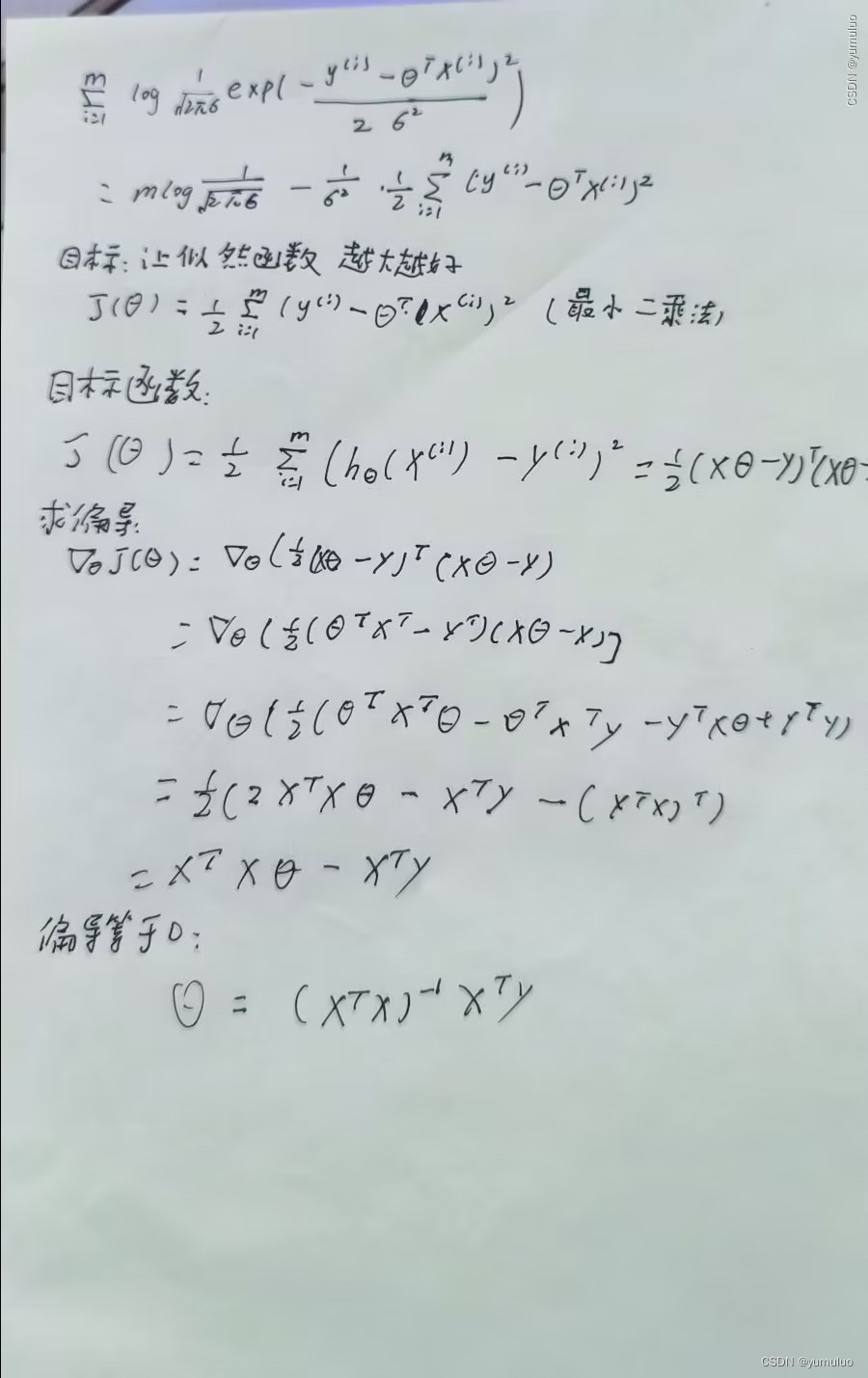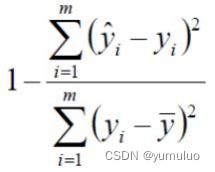(五)误差
1.误差 是独立并且具有相同的分布,并且服从均值为0方差为
的高斯分布
2.独立:张三和李四一起来贷款,他俩没关系
3. 同分布:他俩都来得是我们假定的这家银行
4.高斯分布:银行可能会多给,也可能会少给,但是绝大多数情况下 这个浮动不会太大,极小情况下浮动会比较大,符合正常情况

(六)误差
1.似然函数:
解释:什么样的参数跟我们的数据组合后恰好是真实值
2.对数似然:
解释:乘法难解,加法就容易了,对数里面乘法可以转换成加法
3.展开化简:

(七)评估方法
1.最常用的评估项 :

2. 的取值越接近1我们认为模型拟合的越好
全部代码:
import numpy as np
import pandas as pd
import matplotlib.pyplot as plt
import plotly
import plotly.graph_objs as go
plotly.offline.init_notebook_mode()
from linear_regression import LinearRegression
data = pd.read_csv('../data/world-happiness-report-2017.csv')
train_data = data.sample(frac=0.8)
test_data = data.drop(train_data.index)
input_param_name_1 = 'Economy..GDP.per.Capita.'
input_param_name_2 = 'Freedom'
output_param_name = 'Happiness.Score'
x_train = train_data[[input_param_name_1, input_param_name_2]].values
y_train = train_data[[output_param_name]].values
x_test = test_data[[input_param_name_1, input_param_name_2]].values
y_test = test_data[[output_param_name]].values
# Configure the plot with training dataset.
plot_training_trace = go.Scatter3d(
x=x_train[:, 0].flatten(),
y=x_train[:, 1].flatten(),
z=y_train.flatten(),
name='Training Set',
mode='markers',
marker={
'size': 10,
'opacity': 1,
'line': {
'color': 'rgb(255, 255, 255)',
'width': 1
},
}
)
plot_test_trace = go.Scatter3d(
x=x_test[:, 0].flatten(),
y=x_test[:, 1].flatten(),
z=y_test.flatten(),
name='Test Set',
mode='markers',
marker={
'size': 10,
'opacity': 1,
'line': {
'color': 'rgb(255, 255, 255)',
'width': 1
},
}
)
plot_layout = go.Layout(
title='Date Sets',
scene={
'xaxis': {'title': input_param_name_1},
'yaxis': {'title': input_param_name_2},
'zaxis': {'title': output_param_name}
},
margin={'l': 0, 'r': 0, 'b': 0, 't': 0}
)
plot_data = [plot_training_trace, plot_test_trace]
plot_figure = go.Figure(data=plot_data, layout=plot_layout)
plotly.offline.plot(plot_figure)
num_iterations = 500
learning_rate = 0.01
polynomial_degree = 0
sinusoid_degree = 0
linear_regression = LinearRegression(x_train, y_train, polynomial_degree, sinusoid_degree)
(theta, cost_history) = linear_regression.train(
learning_rate,
num_iterations
)
print('开始损失',cost_history[0])
print('结束损失',cost_history[-1])
plt.plot(range(num_iterations), cost_history)
plt.xlabel('Iterations')
plt.ylabel('Cost')
plt.title('Gradient Descent Progress')
plt.show()
predictions_num = 10
x_min = x_train[:, 0].min();
x_max = x_train[:, 0].max();
y_min = x_train[:, 1].min();
y_max = x_train[:, 1].max();
x_axis = np.linspace(x_min, x_max, predictions_num)
y_axis = np.linspace(y_min, y_max, predictions_num)
x_predictions = np.zeros((predictions_num * predictions_num, 1))
y_predictions = np.zeros((predictions_num * predictions_num, 1))
x_y_index = 0
for x_index, x_value in enumerate(x_axis):
for y_index, y_value in enumerate(y_axis):
x_predictions[x_y_index] = x_value
y_predictions[x_y_index] = y_value
x_y_index += 1
z_predictions = linear_regression.predict(np.hstack((x_predictions, y_predictions)))
plot_predictions_trace = go.Scatter3d(
x=x_predictions.flatten(),
y=y_predictions.flatten(),
z=z_predictions.flatten(),
name='Prediction Plane',
mode='markers',
marker={
'size': 1,
},
opacity=0.8,
surfaceaxis=2,
)
plot_data = [plot_training_trace, plot_test_trace, plot_predictions_trace]
plot_figure = go.Figure(data=plot_data, layout=plot_layout)
plotly.offline.plot(plot_figure)
import numpy as np
import pandas as pd
import matplotlib.pyplot as plt
from linear_regression import LinearRegression
data = pd.read_csv('../data/non-linear-regression-x-y.csv')
x = data['x'].values.reshape((data.shape[0], 1))
y = data['y'].values.reshape((data.shape[0], 1))
data.head(10)
plt.plot(x, y)
plt.show()
num_iterations = 50000
learning_rate = 0.02
polynomial_degree = 15
sinusoid_degree = 15
normalize_data = True
linear_regression = LinearRegression(x, y, polynomial_degree, sinusoid_degree, normalize_data)
(theta, cost_history) = linear_regression.train(
learning_rate,
num_iterations
)
print('开始损失: {:.2f}'.format(cost_history[0]))
print('结束损失: {:.2f}'.format(cost_history[-1]))
theta_table = pd.DataFrame({'Model Parameters': theta.flatten()})
plt.plot(range(num_iterations), cost_history)
plt.xlabel('Iterations')
plt.ylabel('Cost')
plt.title('Gradient Descent Progress')
plt.show()
predictions_num = 1000
x_predictions = np.linspace(x.min(), x.max(), predictions_num).reshape(predictions_num, 1);
y_predictions = linear_regression.predict(x_predictions)
plt.scatter(x, y, label='Training Dataset')
plt.plot(x_predictions, y_predictions, 'r', label='Prediction')
plt.show()import numpy as np
import pandas as pd
import matplotlib.pyplot as plt
from linear_regression import LinearRegression
data = pd.read_csv('../data/world-happiness-report-2017.csv')
# 得到训练和测试数据
train_data = data.sample(frac = 0.8)
test_data = data.drop(train_data.index)
input_param_name = 'Economy..GDP.per.Capita.'
output_param_name = 'Happiness.Score'
x_train = train_data[[input_param_name]].values
y_train = train_data[[output_param_name]].values
x_test = test_data[input_param_name].values
y_test = test_data[output_param_name].values
plt.scatter(x_train,y_train,label='Train data')
plt.scatter(x_test,y_test,label='test data')
plt.xlabel(input_param_name)
plt.ylabel(output_param_name)
plt.title('Happy')
plt.legend()
plt.show()
num_iterations = 500
learning_rate = 0.01
linear_regression = LinearRegression(x_train,y_train)
(theta,cost_history) = linear_regression.train(learning_rate,num_iterations)
print ('开始时的损失:',cost_history[0])
print ('训练后的损失:',cost_history[-1])
plt.plot(range(num_iterations),cost_history)
plt.xlabel('Iter')
plt.ylabel('cost')
plt.title('GD')
plt.show()
predictions_num = 100
x_predictions = np.linspace(x_train.min(),x_train.max(),predictions_num).reshape(predictions_num,1)
y_predictions = linear_regression.predict(x_predictions)
plt.scatter(x_train,y_train,label='Train data')
plt.scatter(x_test,y_test,label='test data')
plt.plot(x_predictions,y_predictions,'r',label = 'Prediction')
plt.xlabel(input_param_name)
plt.ylabel(output_param_name)
plt.title('Happy')
plt.legend()
plt.show()




















 770
770











 被折叠的 条评论
为什么被折叠?
被折叠的 条评论
为什么被折叠?








